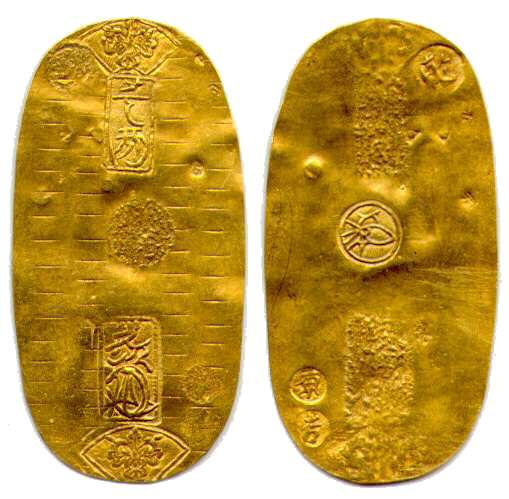Koban
From Marteau

Japan 1710-1714 (Hoei Era) Gold Koban or Ryo
History
Following the monetary reform of 1601 the Koban became the central unit of Japan's gold currency - rivalling the nation's silver and copper money, yet debased with the circulating silver coinage at about the same rate.
| Keicho Koban |
Genroku Koban |
Hoei Koban |
Shotoko Koban |
Kyoho Koban |
Gembun Koban |
|
| 1606 | 1695 | 1710 | 1714 | 1715 | 1736 | |
| Weight | 17.9 | 17.9 | 9.4 | 17.9 | 17.9 | 13.1 |
| Fineness | 84-87% | 57% | 84% | 84-87% | 87% | 66% |
| Gold g | ~15.30 | 10.20 | 7.89 | ~15.30 | 15.57 | 8.64 |
| Value | 100% | 66.66% | 51.57% | 100% | 101.76% | 56.47% |
The official gold/silver rate was at 1 Ryo gold coin = 50 momme of silver coins = 4000 mon of copper coins, the momme being a unit of weight equal to 3.75 g.
Fluctuations of the supply and demand and the changing quality of gold and silver minted subjected the gold/silver rate to changing market evaluations. The Kenji gold Koban Japan's dynasties and rulers) minted in the 16th century stood at 60 momme of silver, the Keicho gold Koban of 1601 had had a value of 80-90 momme silver, the Genroku gold Koban of 1695 was accepted as an equivalent of 70 momme silver Honjo, Eijiro (1940), p.6 pdf.
See Money (Japan).
Literature
- Bank of Japan (ed.) Short Essays on Monetary History Contained in Monetary and Economic Studies, 1-6 Keicho Koban: Establishment of the Unified Currency System. link
- Bank of Japan (ed.) Short Essays on Monetary History Contained in Monetary and Economic Studies, 1-8: The Genroku, Hoei, Shotoku, Kyoho, and Gembun Koban. link
- Honjo, Eijiro, "The Ecomonmic thought in the midde period of the Tokugawa period", Kyoto University Econmonic Review, vol. xv, no. 2 (Kyoto, April 1940), p.1-33. (On monetary politics, price developments and the relatinonship between coinage and price developments, 1688-1763) pdf
Subpage of the Marteau Platform of Research in Economic History
